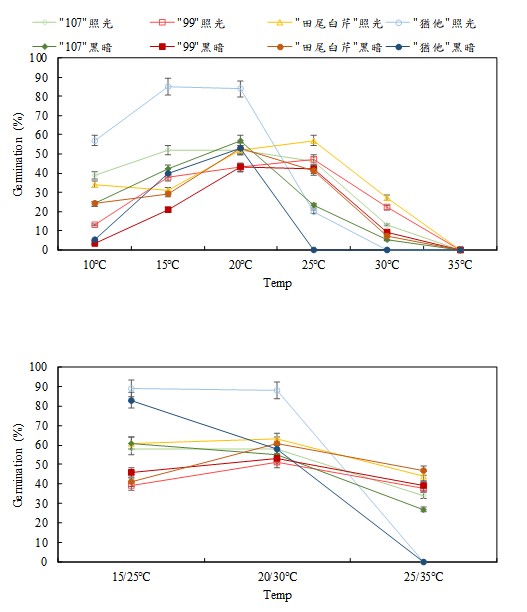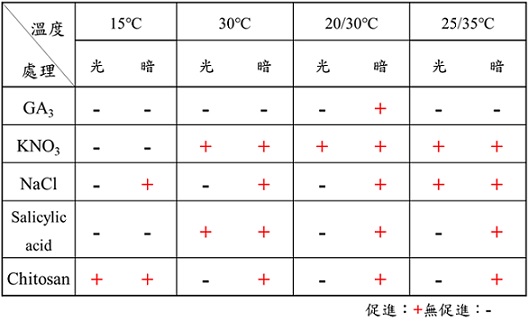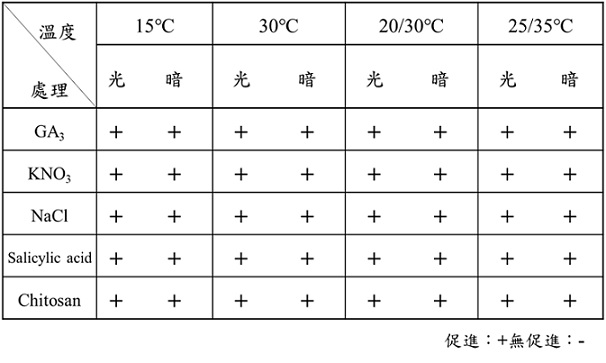- Research on processing technology for reducing the waste of domestic agricultural production
- (d)Tomato seed preparation and multi-product development
- (c) Establish the system of value-added utilization on pumpkin residues from seedling industry
- (b)Development of value-added products from seeded papaya wastes
- (a)Developement of eco-friendly nursery material technology
- Application of Herbal Medicine Plants in Animal Feed additives and establishment of GAP production system
- Construction and extension of demonstrative organic nursery
- Study on the Development and Industrial Value of Biochar which made by used medium of Mushroom
- Establishment of single nucleotide polymorphism (SNP) markers for resistance genes detection in tomato and purity testing of F1 hybrid watermelon seed.
- To construct the Intelligent Vegetable Seedling Production and Sales Management System
- Establishing physiological parameters and production operation mode for vegetable nursery
- Application of production management information system in plant tissue culture
- The Establishment of high through-put Sequencing technique to detect potato virus
- Establishment of highly effective isolated facility for healthy seedling
- Using seed priming treatment to promote crop stress tolerance and survey industry status
- Development of the molecular marker for male sterility and fertility restorer in Capsicum Annuum L.
- Development of potyvirus resistance in melon using CRISPR/Cas9 technology
- The study of healthy seedling production by in vitro micropropagation
- The establishment and application of specific molecular markers to detect bacterial spot resistance gene in tomato.
- Strengthen Plant New Variety DUS Testing Techniques and Research on Genetic Resources Management and Application of the Potential Crops in Taiwan
- Potential bulb flowers breeding of exportation
- Breeding and Research on Key Techniques of Orchids – Research on Flowering Regulation of Paphiopedilum.
- Breed and assess the drought tolerance rootstocks with cucumber
- Breeding for disease resistance in tomato and high quality eggplant.
- Breeding for Cucurbitaceae vegetables
- Intelligent Marketing and Promotion of Seedling Production and Marketing Information Management System
- Establishment of Phalaenopsis Varieties Identification and Enterprise Application Integration Platform
- Establish a digital platform for seed illustration
- The performance evaluation and working tendency analysis for the seedling training courses in Farmers' Academy
- Visiting the Netherlands for Studying on Polyploidy Breeding and Production System of Bulb Flowers
- Study and Exchange on Plant Variety Protection System and DUS Techniques bewteen Taiwan and Thailand
- Establishment of inspection and monitoring system for new era genetically modified organisms
- Study of inspection acts for imported genetically modified feed and industrial applications traceability and export agricultural products
 Home > Achievement > 2019 Research Project List > Using seed priming treatment to promote crop stress tolerance and survey industry status Home > Achievement > 2019 Research Project List > Using seed priming treatment to promote crop stress tolerance and survey industry status |
Using seed priming treatment to promote crop stress tolerance and survey industry status
The germination test of celery seeds at different temperatures and illumination showed, the optimum temperature for germination of the four cultivars (local smallage Ching Tung "107" and "99", Ching Yeh Pai Ku "Tian Wei", celery "UTAH") was 15℃-25℃. The germination rate decreased significantly at lower or higher temperature, and all cultivars could not germinate at 35℃. The inhibition of germination in dark at low temperature (10℃) and high temperature (above 30℃) is more significant than that at appropriate temperature. Among them, "UTAH" is most sensitive to temperature and illumination (figure. 1 top). Alternating temperatures can promote the germination of celery seeds and reduce the inhibitory effect of dark (figure. 1 bottom).

▲Fig. 1. The effect of temperature and illumination on germination of celery seeds.
In addition, celery seeds were treated with different priming solvents(GA3, KNO3, NaCl, Salicylic acid, Chitosan) and temperature (6, 12, 24 hours at 15℃). The test results show that different priming solvents have different effects on the germination of celery seeds. GA3 only significantly increased the germination rate of celery "Utah" in the dark at 20/30℃. In addition to the low temperature of 15℃, potassium nitrate (KNO3) can significantly improve the germination rate in light and dark. NaCl can significantly improve the germination rate at all temperatures in dark, salicylic acid can improve the germination at the higher temperature and alternating temperatures in dark, chitosan can improve the germination at the lower temperature and alternating temperature in dark (table 1). All priming solvents could decrease the time to 50% germination (GT50)(table 2).

▲Fig. 2. The effect of priming treatment on germination of celery seeds.

▲Fig. 3. The effect of priming treatment to decrease the time to 50% germination of celery seeds.
